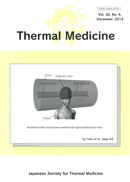All issues

Volume 30 (2014)
- Issue 4 Pages 41-
- Issue 3 Pages 27-
- Issue 2 Pages 13-
- Issue 1 Pages 1-
Volume 30, Issue 4
Displaying 1-1 of 1 articles from this issue
- |<
- <
- 1
- >
- >|
Original Paper
-
YUYA ISEKI, HIDEAKI TAKAHASHI, TAKEO UZUKA, KAZUO KATO2014 Volume 30 Issue 4 Pages 41-53
Published: December 20, 2014
Released on J-STAGE: January 16, 2015
JOURNAL FREE ACCESSThis paper describes a new heating control method of the proposed resonant cavity applicator for non-invasive brain tumor hyperthermia treatments. In the previous study, the resonant cavity applicator for treating brain tumors was proposed. In the present study, a dielectric bolus was used to control the heated location inside brain tumors. The dielectric bolus was divided into four sections filled with dielectric materials, such as water, and was attached to the human head inside the cavity. By changing the dielectric materials inside each section, the heated location could be controlled inside brain tumors. In this paper, first, the method for controlling the heated location with the dielectric bolus was presented. Second, two types of numerical models to calculate temperature distributions were described. First, we used a cylindrical phantom model for the basic study to check the ability of the proposed method. Second, we used a 3-D anatomical human head model which was reconstructed from 2-D medical images by using the 3-D computer aided design (CAD) software. Finally, the temperature profiles calculated by the 3-D finite element method (FEM) and heating experiments heated by the developed heating system were discussed. From the results of computer simulations and heating experiment with the agar phantom, it was confirmed that the results of the computer simulations were in close agreement with the results of the heating experiments with an error of 10% or less. Next, we calculated the temperature distribution of the 3-D anatomical human head model that takes into account the cooling effect of blood flow. The proposed heating method covered approximately 97% of the brain tumor size without an undesirable hotspot. From these results, it was found that the proposed heating control method is useful for effective hyperthermia treatments.View full abstractDownload PDF (1142K)
- |<
- <
- 1
- >
- >|